The Lifecycle of a Roof: What Residents Should Expect
websitebuilder • June 20, 2025
Understanding the Lifespan of Common Roofing Materials in Arizona
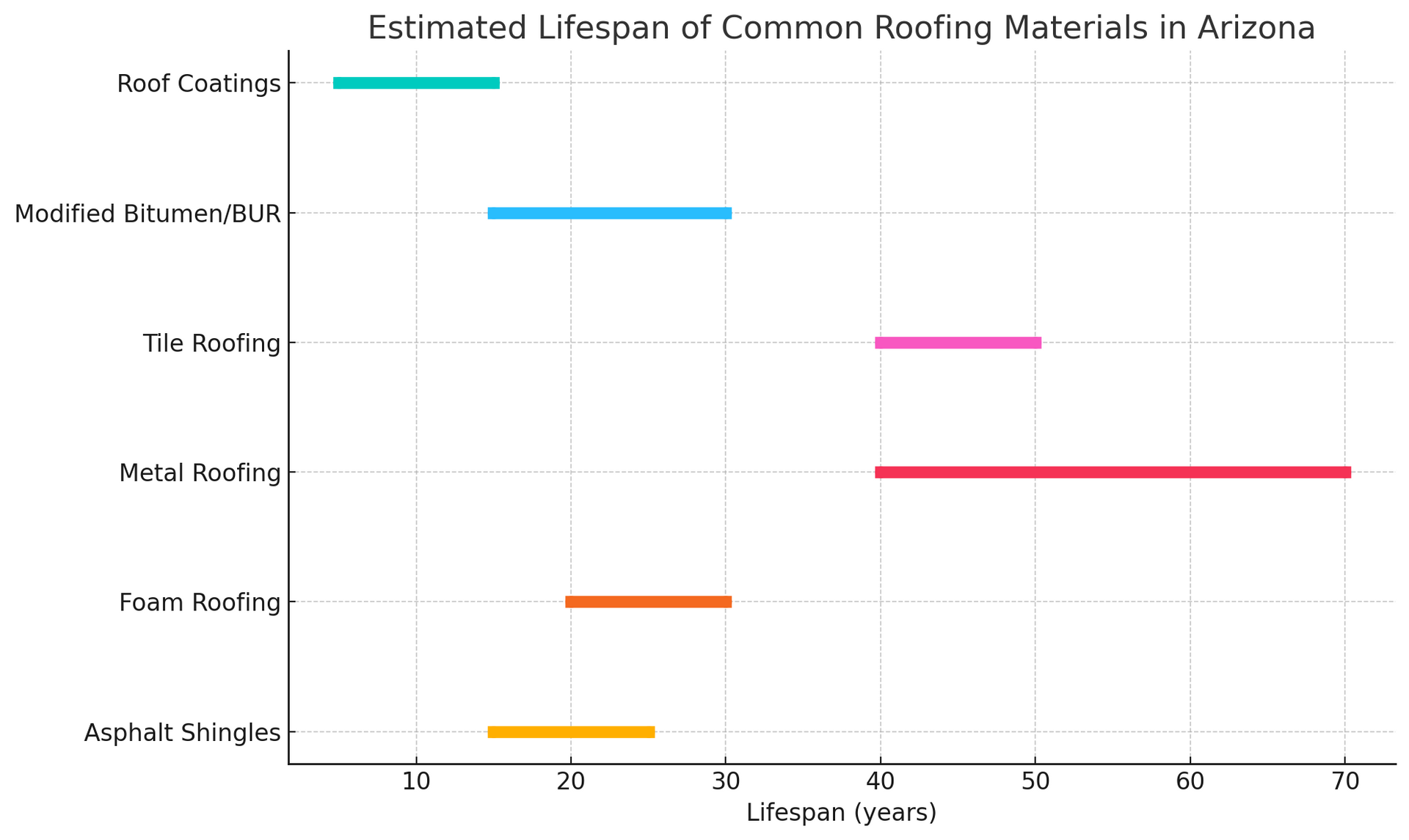
Your roof is more than just shingles and tiles, it’s your home’s first line of defense against heat, wind, rain, hail, and snow. And just like every other part of your home, roofs have a lifespan. Knowing what to expect from your roofing material can help you plan for maintenance, avoid emergency repairs, and budget for future replacement. Here's a breakdown of the typical lifecycle of roofing systems commonly found in Arizona:
Asphalt Shingles
Lifespan:
15–25 years
Common in:
Residential neighborhoods across Northern Arizona and North Phoenix
Asphalt shingles are affordable and widely used, but the intense sun and monsoon storms in Arizona can speed up wear and tear. Regular inspections and timely repairs can extend the life of your shingle roof. Look for signs like curling edges, missing granules, or cracked shingles as early indicators it may be time for attention.
Metal Roofing
Lifespan:
40–70 years
Common in: Custom homes, cabins, and fire-prone areas in Northern Arizona
Metal roofs are incredibly durable and resistant to fire, pests, and weather. Their reflective properties also help reduce heat absorption, perfect for Arizona’s desert and mountain climates. You may notice some fading or minor dents over time, but structurally, metal is built to last.
Tile Roofing (Clay or Concrete)
Lifespan:
40–50 years (underlayment may need replacing after 20–30 years)
Common in:
Southwestern-style homes across the region
Tile roofs hold up well in Arizona’s sun and storms, but the underlayment beneath the tiles often wears out first. You may need to replace or repair this layer to maintain your roof’s integrity. Tiles can also break if walked on improperly, so always call a pro for inspections or repairs.
Roof Coatings
Lifespan:
5–15 years (depending on material and maintenance)
Used on:
Foam, modified bitumen, metal, and flat roofing systems
Roof coatings act like sunscreen for your roof—reflecting UV rays, reducing heat absorption, and sealing the surface to prevent water intrusion. In Arizona’s harsh climate, coatings are a popular way to extend the life of an existing roof without a full replacement. With regular reapplications every few years, coatings can significantly enhance performance and add years to your roof’s life. Signs it might be time to recoat include ponding water, surface cracks, or visible wear and chalking.
Foam Roofing (Spray Polyurethane Foam)
Lifespan:
20–30 years (with proper maintenance)
Common in:
Flat roofs, especially commercial and desert-style homes
Foam roofs are great for insulation and energy efficiency, but they require periodic recoating (every 5–10 years). If well-maintained, these roofs can last decades. Keep an eye out for ponding water or surface cracks and schedule regular maintenance to prevent issues.
Modified Bitumen & Built-Up Roofing (BUR)
Lifespan:
15–30 years
Common in:
Commercial buildings and flat-roofed homes
These roofs are durable and designed for flat applications. Lifespan depends heavily on installation quality, foot traffic, and exposure to UV rays. Regular inspections and coatings help maximize longevity.
What Impacts Roof Lifespan in Arizona?
• Sun exposure:
UV rays break down materials faster, especially in the desert.
• Weather events:
Monsoons, snow, hail, and high winds can cause damage.
• Ventilation & insulation:
Poor attic ventilation can shorten a roof’s life by trapping heat and moisture.
• Maintenance:
Regular cleanings, inspections, and minor repairs extend any roof’s lifespan.
Final Thoughts
Your roof’s lifespan isn’t just about material it’s, about how well it’s cared for. Annual inspections, clearing debris, addressing small issues early, and investing in quality installation can help your roof protect your home for decades.
Knowing what to expect gives you peace of mind and helps you make informed decisions as a homeowner.

In today's digital age, Artificial Intelligence (AI) has made information more accessible than ever. Whether you're trying to understand the differences between asphalt shingles and metal roofing, or comparing durability, cost, and style, AI tools like chatbots and search engines can provide helpful overviews. But when it comes to something as critical as your home's roofing system , relying entirely on AI is a mistake you can’t afford to make. Here’s why direct communication with a professional roofer is absolutely essential , even in the age of intelligent machines. 1. AI Doesn’t Know Your Roof AI provides general information and while that’s great for getting started, it won’t know the specific details of your home. Things like: The current state of your roof Local building codes and weather conditions The structural integrity of your home Installation challenges unique to your roofline Only a qualified roofing contractor, who can inspect your property in person, will be able to offer reliable recommendations tailored to your situation. 2. You Need Manufacturer Specifications & Documentation AI can tell you what TPO or architectural shingles are, but it can’t provide the actual product documentation you’ll need for decision-making or warranty coverage. When working with a roofing contractor, you can (and should!) request: Manufacturer specs and data sheets Warranty documentation Maintenance guidelines Installation standards specific to each product This paperwork is crucial, especially if you're making a long-term investment or filing insurance claims. It ensures that your roofing materials are installed according to the manufacturer’s requirements, which AI simply can’t guarantee. 3. Ask Questions and Get Real Answers AI can answer basic questions like “What’s the lifespan of a metal roof?”...but it can’t walk you through your contractor's installation timeline, material availability, or custom pricing . These are discussions that must happen with your roofing professional. A skilled and licensed roofer will: Help you compare roofing systems that fit your climate, budget, and goals Explain how your attic ventilation affects roof life Offer solutions based on experience, not just information Respond to follow-up questions as your project progresses Open, two-way communication builds trust and clarity, and prevents costly misunderstandings. 4. Roofing Is a Major Investment, Don’t Leave It to Algorithms Replacing or repairing a roof is often one of the largest investments a homeowner makes. While AI is a convenient research tool, it can’t visit your property, provide references, or stand behind the quality of its recommendations. Your home deserves more than a search result, it deserves professional care backed by real-world experience and accountability. The Bottom Line AI is a great starting point for learning about roofing materials and options. But when it’s time to make decisions, talk to your roofer . Ask questions. Request documents. Understand the process. And remember, no chatbot can replace the insight, training, and responsibility of a licensed roofing professional. Need advice from a real roofing expert? Give us a call at 928-366-3504 or 602-725-7949 , visit us online at www.northernarizonaroofservices.com to schedule a consultation. We’re happy to answer your questions — no robots required.
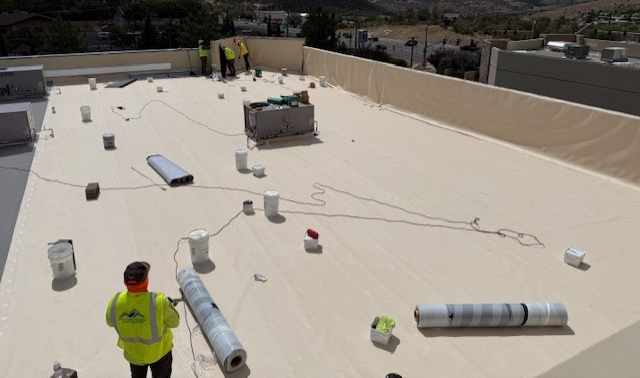
Your commercial roof is more than a protective layer, it’s the first line of defense against Arizona’s intense sun, monsoon rains, hail, and snow. Over time, even the most durable systems reach the end of their service life. Recognizing early warning signs can save you from costly damage, operational downtime, and emergency repairs. Here’s a practical checklist to help you determine when it might be time to replace your commercial roof. 🔍 1. Frequent Leaks or Repairs If you’re calling for patchwork repairs more than once a season, your roof may be signaling that its waterproofing system has failed. Repeated leaks are often a symptom of aged membranes, worn flashings, or underlying deck damage that can no longer be solved with temporary fixes. 🕳️ 2. Ponding Water That Doesn’t Evaporate Flat and low-slope roofs are especially prone to ponding. Water that lingers for more than 48 hours accelerates membrane deterioration, increases the risk of leaks, and adds unnecessary weight to your structure. If drainage issues persist despite maintenance, replacement may be the safest long-term solution. 🧱 3. Visible Surface Damage Check for cracks, blisters, exposed insulation, or deteriorating seams, all common indicators of aging materials. If your roof shows extensive wear across large areas (not just isolated spots), a full reroof may be more cost-effective than repeated patching. ⚡ 4. Rising Energy Costs An aging or poorly insulated roof can make your HVAC system work overtime. If you’ve noticed higher energy bills, it could be due to lost reflectivity or damaged insulation layers. Newer systems, such as silicone-coated, foam, or reflective TPO membranes, help improve energy efficiency and comfort. 🧰 5. Warranty Expiration and Roof Age Most commercial roofs last 15–25 years, depending on the system and maintenance history. If your warranty has expired or your roof is nearing the end of its expected lifespan, it’s wise to schedule a professional evaluation to plan for replacement before leaks or failures occur. 📉 6. Interior Signs of Trouble Ceiling stains, peeling paint, and musty odors inside the building often point to hidden roof damage. Moisture intrusion can compromise insulation and create mold issues that affect air quality and structural integrity. 🧾 7. Compliance and Insurance Requirements Some insurers and municipalities require roofs to meet updated codes or performance standards. Replacing an outdated system not only enhances safety but may also qualify your property for lower insurance premiums or tax incentives. 🏗️ Planning Ahead Pays Off A roof replacement is a significant investment, but one that protects your building, tenants, and business continuity. By tracking these warning signs and performing regular inspections, you can budget proactively instead of reacting to emergencies. When it’s time to evaluate your commercial roof, Northern Arizona Roof Services provides expert inspections, honest recommendations, and high-quality installations backed by our 'No Leaks' Guarantee. 📞 928-366-3504 🌐 www.northernarizonaroofservices.com Licensed • Bonded • Insured
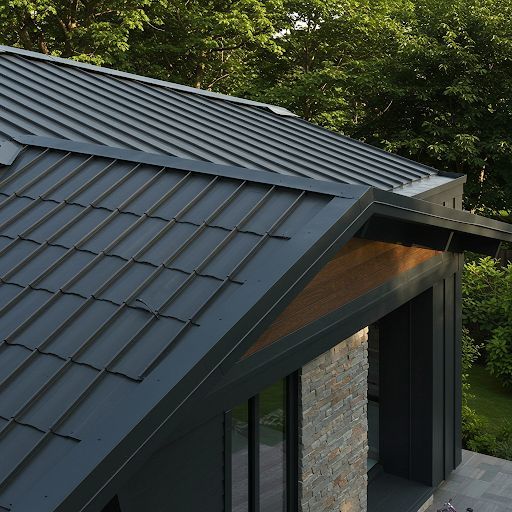
When it comes to protecting your home, your roof is the first, and most critical, line of defense against Arizona’s intense weather conditions. From high winds and hail to wildfire embers that can travel over a mile, the roof you choose determines how well your home stands up to nature’s toughest challenges. That’s where metal roofing shines, literally and figuratively. Durability You Can Count On Metal roofs are engineered for strength. They withstand heavy winds, hail, and even flying debris far better than traditional shingles. While asphalt shingles can crack, curl, or blow off in harsh weather, metal panels remain intact, providing superior protection for decades. A properly installed metal roof can last 50 years or more, making it one of the most durable roofing materials available. Fire Resistance That Matters In wildfire-prone regions like Northern Arizona, fire protection is more than a benefit, it’s a necessity! Embers can travel long distances through the air, landing on rooftops and igniting flammable materials. Metal roofing systems are non-combustible and create a critical barrier between your home and airborne embers. It’s an extra layer of defense that can make all the difference when every second counts. Environmentally Responsible Roofing Choosing metal roofing isn’t just about durability, it’s about sustainability. Unlike shingles, which often end up in landfills after replacement, metal roofs can be recycled. When a metal roof eventually reaches the end of its life, it can be taken to a scrap metal yard instead of the dump. Many metal roofs are even made from recycled materials, minimizing waste and supporting a circular economy. Energy Efficiency and Long-Term Value While the initial investment for a metal roof can be higher than asphalt shingles, the long-term savings are significant. Metal roofs reflect sunlight instead of absorbing it, helping to keep your home cooler and reduce energy bills during hot Arizona summers. Conversely, for homes in colder regions of Arizona, darker metal panels and metal shingles can help attract and retain heat, keeping your home warmer and more energy efficient during the winter months. Homeowners may also forgo being canceled or dropped by their insurance company thanks to the enhanced protection metal roofs provide against fire, hail, and wind damage. Invest Once, Protect for Decades A metal roof may require a larger upfront investment, but it’s a long-term solution that pays for itself through energy savings, insurance benefits, and reduced maintenance. Most importantly, it gives you peace of mind knowing your home is protected by one of the most resilient and environmentally responsible roofing systems available. At Northern Arizona Roof Services, we specialize in high-performance metal roofing systems designed for Arizona’s unique climate. Whether you’re looking for modern standing seam panels or the timeless look of stone-coated steel, we can help you choose a solution that delivers strength, beauty, and sustainability for years to come. 📞 Call 928-366-3504 or visit www.northernarizonaroofservices.com to schedule your free estimate today.
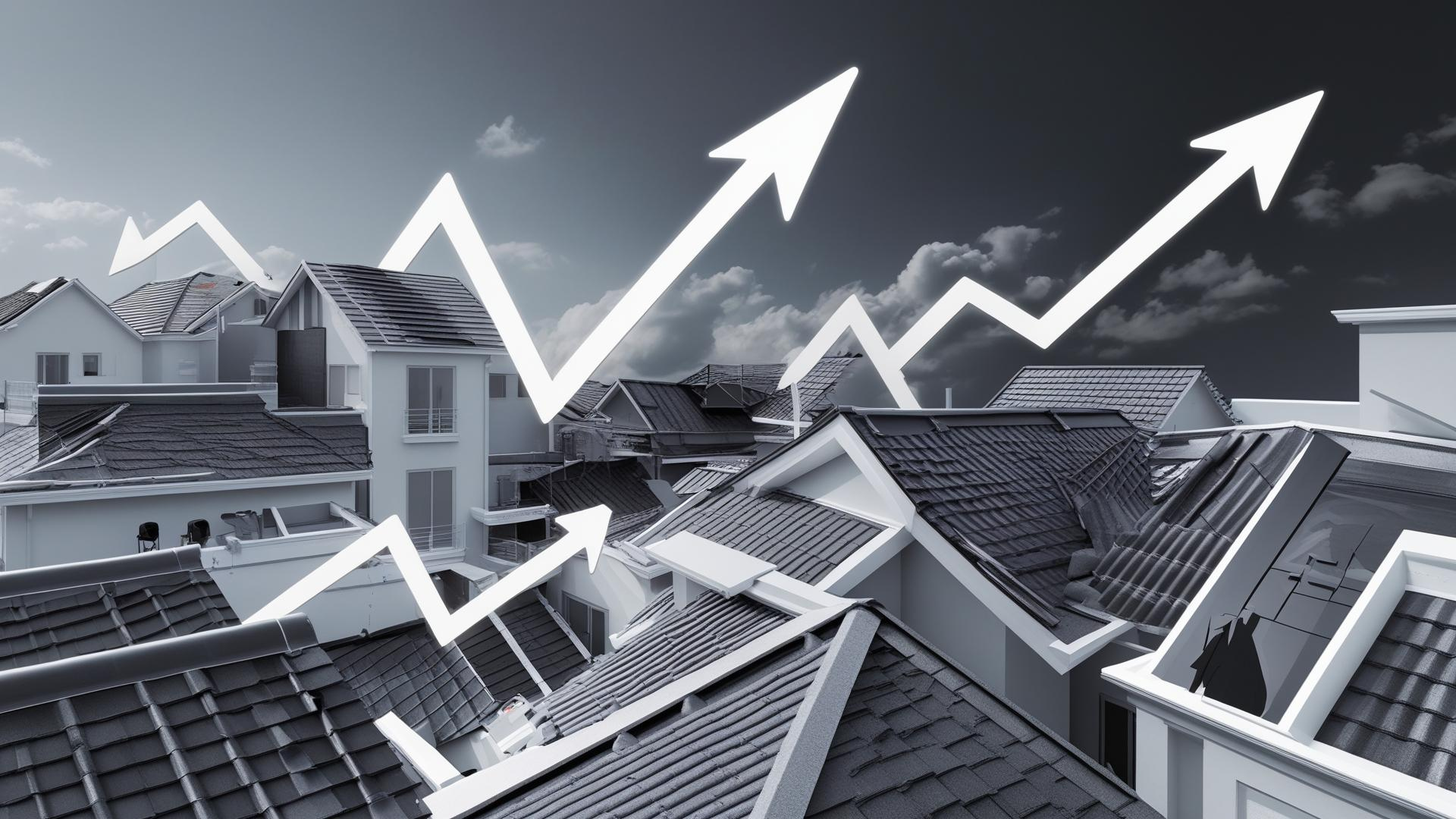
As the year comes to a close, many business owners and property managers are taking a closer look at their budgets, and for good reason. The final quarter is the perfect time to plan and allocate capital expenses (CapEx) that can enhance your property’s value, improve energy efficiency, and reduce long-term maintenance costs. One of the smartest places to invest? Your roof. Why Roofing Is a Strategic Year-End Investment Your roof does far more than protect your building, it plays a major role in energy performance, insurance rates, and property value. Addressing roofing needs before year-end offers several financial and operational advantages: Tax Benefits: Many roofing projects qualify for accelerated depreciation or full expensing under Section 179 of the tax code. That means you may be able to deduct up to $2.5 million in roofing improvements made before December 31, 2025. Budget Utilization: If you have unused capital funds, allocating them toward preventive maintenance or re-roofing ensures your budget is put to productive use rather than being forfeited. Reduced Disruptions: Scheduling roofing work during slower business months helps avoid peak-season interruptions. Enhanced Property Protection: Arizona’s winters can bring freezing temperatures, snow, and ice. Ensuring your roof is sealed, insulated, and ready can prevent costly leaks or damage in the coming year. Types of Year-End Roofing Projects to Consider Whether your goal is long-term performance or proactive maintenance, these projects can be excellent capital investments: Roof Replacements or Restorations – Upgrade aging systems with energy-efficient materials such as TPO, silicone coatings, or metal roofing that reduce cooling costs and extend service life. Preventive Maintenance & Repairs – Address small issues before they become major expenses. End-of-year maintenance can help you start the new year with a roof in top condition. Roof Coatings & Waterproofing – Silicone and elastomeric coatings can renew older roofs at a fraction of the cost of replacement, while improving reflectivity and energy efficiency. Gutter, Heat Tape & Snow Guard Installation – Prepare your property for winter weather and prevent damage from ice buildup or poor drainage. Plan Ahead for a Strong Start to the New Year At Northern Arizona Roof Services, we help commercial and residential clients across Flagstaff, North Phoenix, and surrounding communities make informed decisions about their roofing investments. Our team can evaluate your current system, provide detailed recommendations, and work with your accountant or property manager to align your project with your end-of-year financial goals. Let’s Secure Your Investment Before December 31 Now is the time to schedule your inspection or estimate to ensure work can be completed, or at least contracted, before year-end to qualify for potential tax benefits. 📞 Call 928-366-3504 or 602-725-7949 🌐 www.northernarizonaroofservices.com 💬 Free estimates | Licensed • Bonded • Insured | Home of the “No Leaks Guarantee”

When you're preparing for a roofing project, it's natural to request multiple estimates. Comparing quotes seems like a smart first step, and it is. But one thing surprises many homeowners: the wide range of prices they receive for what seems to be the exact same job. At first glance, one estimate may appear to be a much better deal, especially if it’s significantly lower. But here’s the honest truth: no two roofing estimates are ever truly the same , and the lowest price isn’t always the best value. What Makes Roofing Estimates So Different? Each roofing contractor evaluates your project through a different lens, based on their materials, processes, labor costs, overhead, and experience. Even if you're asking for the same job across the board, quotes can vary widely due to: Material Quality: Are you being quoted for basic asphalt shingles or premium-grade options? What kind of underlayment is included? Scope of Work: One estimate may include flashing, ridge vents, or new gutters, while another might not. Building Code Compliance: Some roofers quote only to the minimum code requirement, while others include best practices that exceed code. Certifications & Warranty Coverage: Contractors certified by top manufacturers often include enhanced warranties you won’t find with uncertified providers. Experience & Reputation: A well-established, licensed contractor with a strong reputation may charge more, but they also bring peace of mind. The Importance of Transparency Many homeowners unknowingly fall for low bids that look good on paper, but come with hidden fees . A common example is credit card processing fees , often added after the estimate has been accepted. These can be 3% or more, and when you factor them in, that “lower” invoice might actually cost as much if not more, than a seemingly higher, all-inclusive quote from a more transparent contractor. Another difference lies in installation practices. For instance, one roofer might only apply ice and water shield at the roof’s edges to meet minimum code, while another applies it across the entire roof to provide maximum protection against leaks. That’s a big difference in both performance and price. Doing Your Due Diligence As a homeowner or commercial building owner, it’s your responsibility to understand what’s included, and what’s not, in each estimate . Take time to ask for a detailed breakdown of labor, materials, warranties, payment terms, and any potential fees. Don’t be afraid to ask why one bid is higher or lower. A trustworthy contractor will be happy to explain. The Bottom Line Roofing isn’t just a purchase, it’s an investment in your property’s safety, longevity, and value. The true cost of your roof isn’t just what you pay upfront; it’s what you’re getting in return. Quality materials, proper installation, warranty coverage, and a contractor you can trust all contribute to long-term savings and peace of mind. When comparing estimates, remember: you're not just comparing prices, you’re comparing standards. Ready to compare quotes with confidence? Let us provide a clear, detailed estimate with no hidden fees, so you know exactly what you're getting. 📞 Call (928) 366-3504 or visit northernarizonaroofservices.com to schedule your free estimate today!
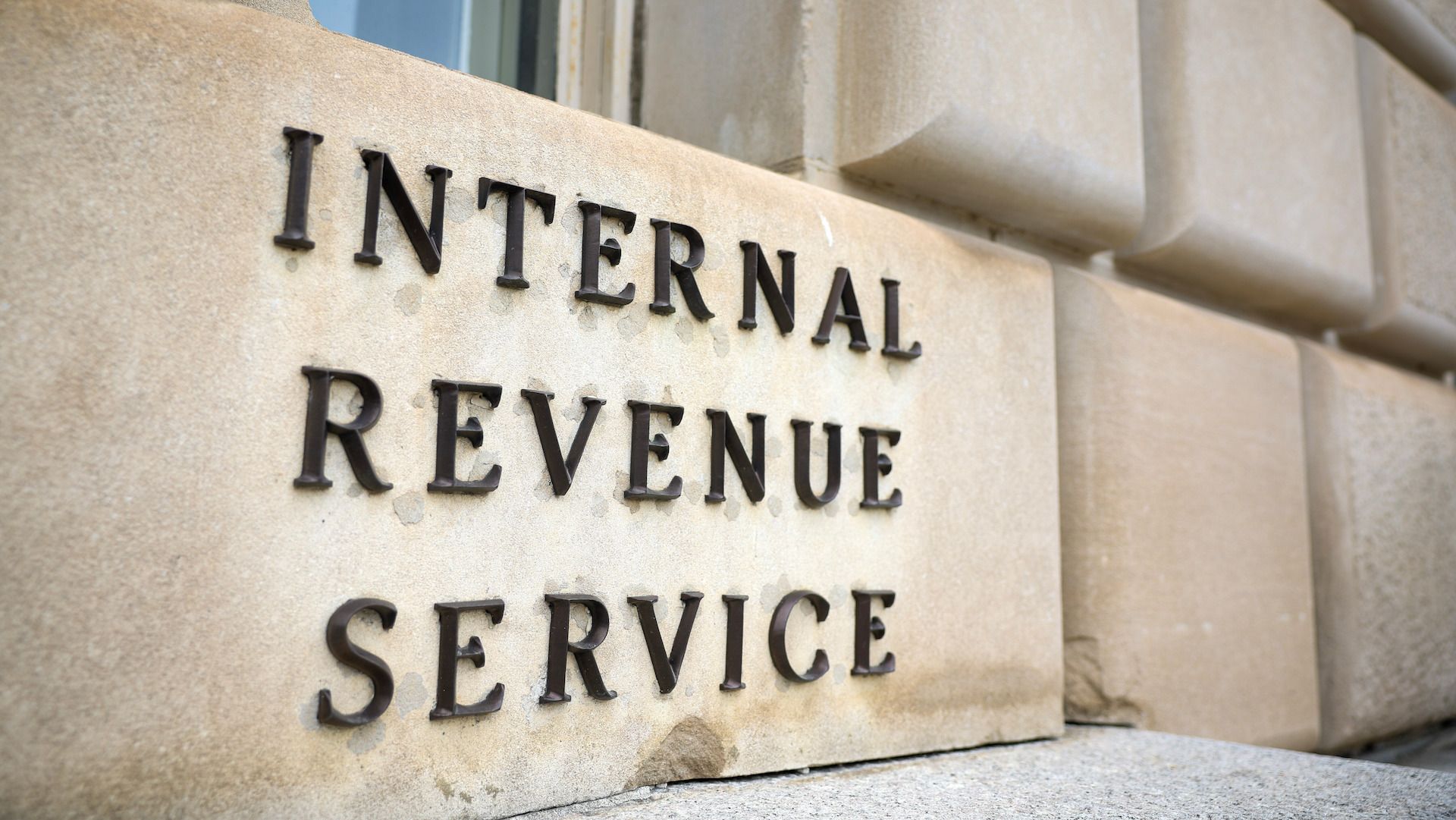
At Northern Arizona Roof Services, we believe a strong roof isn’t just protection, it’s an investment in your business, your property value, and your peace of mind. And thanks to the recently passed One Big Beautiful Bill Act (Public Law No. 119-21) , there’s never been a better time to make that investment. This new legislation expands Section 179 tax benefits , providing substantial incentives for commercial property owners to upgrade or replace existing roofs on nonresidential buildings. What’s Changed with Section 179? Under the updated law, the Section 179 expensing cap has increased from $1 million to $2.5 million for qualified nonresidential real property...including roofing. This means you can now immediately deduct the full cost of qualified roofing improvements, including complete reroofing projects, up to $2.5 million for purchases made after December 31, 2024 . The phase-out threshold has also increased to $4 million , with both limits indexed for inflation, making it easier for even more building owners to qualify for these expanded tax benefits. What This Means for You In practical terms, this change transforms what was once a 39-year depreciation schedule into a one-year, bottom-line tax benefit . By taking advantage of Section 179 expensing , property owners can: 💰 Maximize cash flow by deducting the full project cost in the same year it’s completed 📉 Reduce taxable income while investing in critical property improvements 🏢 Free up capital for other upgrades or operational priorities 📆 Plan strategically , since Section 179 expensing is available annually It’s more than a tax incentive, it’s a smart financial strategy that turns essential maintenance into measurable ROI. Why Roofing Matters More Than Ever A roof does more than keep out the elements, it safeguards your inventory, equipment, and people. As energy costs rise and Arizona’s weather grows more extreme, investing in a high-performance commercial roofing system can reduce long-term costs and improve building efficiency. Whether you’re managing retail centers, warehouses, offices, or educational facilities, upgrading your roof under Section 179 isn’t just compliance, it’s confidence. Let’s Create a Plan That Works for You If you’ve been considering a roof replacement, restoration, or upgrade , now is the time to act. Our experienced team at Northern Arizona Roof Services will help you: Evaluate eligible improvements Review energy-efficient roofing options Align your project with both operational and financial goals We’ll guide you through every step, from design to completion, ensuring your investment not only protects your property but also works to your financial advantage. For additional details on Section 179 expensing, visit the IRS website: 🔗 IRS Publication 946 Or reach out to Northern Arizona Roof Services today to schedule a consultation and start planning your project. 📞 928-366-3504 | 602-725-7949 🌐 www.northernarizonaroofservices.com Licensed • Bonded • Insured • No Leaks Guarantee
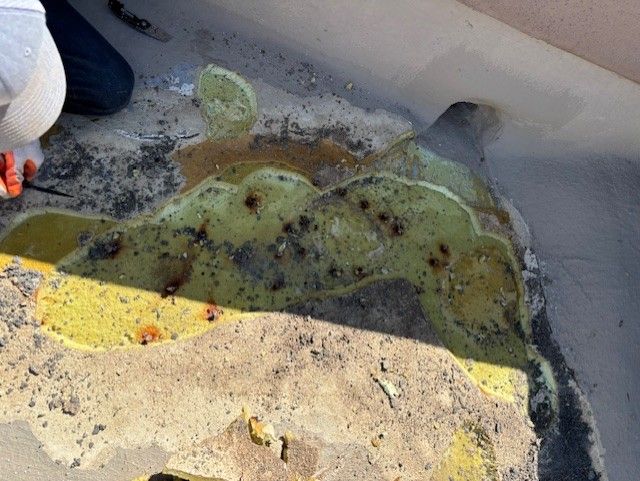
When you live in Arizona, your roof does more than just cover your home — it defends it. From blistering summer sun to sudden monsoon storms, your roof quietly takes the beating so your family doesn’t have to. But lately, Arizona’s weather hasn’t been so quiet. We’re seeing hotter days, stronger winds, and more unpredictable rain — all while wildfire danger creeps closer to neighborhoods that were once considered “safe.” The same elements that make our state breathtaking are the ones testing our homes more than ever before. The Changing Arizona Sky Ask any longtime Arizonan — the seasons don’t feel the same anymore. Monsoons are flashier and faster. Wind gusts seem stronger. Hailstorms appear where they never used to. And that dry heat? It’s now the kind that bakes rooftops, dries out sealants, and cracks shingles long before their expected lifespan. This is the new normal and it’s changing what it means to have a durable, dependable roof in Arizona. A Shift in Priorities: Strength, Safety, and Sustainability Homeowners are rethinking what they want out of a roof. They’re asking questions like: What material will last through these temperature swings? Is there something that looks beautiful but still protects my family from fire risk? Can I invest once and feel confident for decades? The answer lies in smarter roofing solutions built for Arizona’s reality. Metal roofing, for example, reflects heat and provides a long lifespan. Composite roofing like Brava tiles offers the timeless charm of wood shake, but with the fire resistance of metal and sustainability of recycled materials. Even traditional shingles have evolved with high-performance options like GAF HDZ, designed to hold tight in powerful wind and monsoon conditions. These are more than materials — they’re peace of mind. Roofing with Purpose At Northern Arizona Roof Services, we see firsthand what homeowners face after each storm season from the leaks, to the hail bruises, and the “I thought my roof had another few years” surprises. But we also see something else: resilience. We see families who love their homes enough to invest in them. We see retirees protecting the cabin they built decades ago. We see new parents making sure their roof is safe before the baby arrives. And we see communities coming together because in Arizona, it’s never if the next storm or fire season comes, it’s when. That’s why we believe in doing roofing differently: ✔️ Systems that last longer and perform better. ✔️ Materials that reflect Arizona’s beauty while standing up to its extremes. ✔️ And service built on trust, education, and care — not just a sale. Your Roof, Your Story Every roof tells a story of the people beneath it, the storms it’s weathered, and the years it’s protected what matters most. So if it’s been a while since your roof was checked, or you’ve been wondering whether it’s ready for another Arizona summer or winter freeze, don’t wait for a leak to write the next chapter. Schedule your no-cost, no-obligation roof assessment and let’s make sure your home is ready for whatever the Arizona sky brings next. Because when it comes to your roof, and your peace of mind, you deserve no less than a 'No Leaks' Guarantee. Northern Arizona Roof Services 📞 928-366-3504 | 602-725-7949 🌐 www.northernarizonaroofservices.com Licensed • Bonded • Insured • Financing Available • No Leaks Guarantee
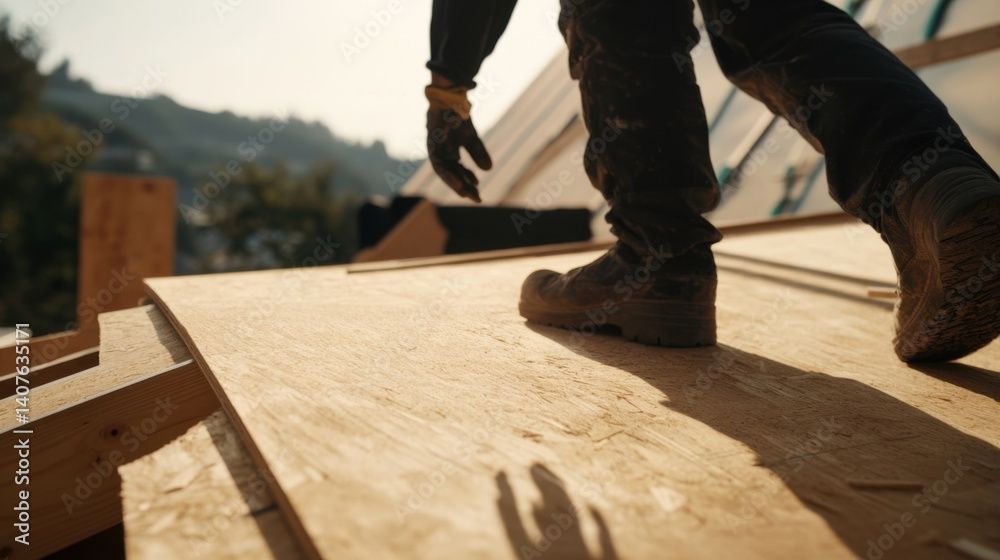
If you’ve ever glanced at a roofing estimate and thought, “Wait… why is the plywood so expensive? I saw it for way less at the hardware store!” — you’re not alone. It’s a common question, and one we completely understand. At first glance, it might seem like a contractor is marking up the material. But the truth is, there’s a lot more to that line item than just the cost of the wood itself . When you see “plywood decking replacement” on your roofing invoice, you’re paying for much more than a single sheet of lumber — you’re paying for the skill, time, labor, tools, and safety it takes to install it properly. Let’s take a closer look behind the scenes. 🔨 Step 1: Tearing Off the Old Decking Before new plywood ever makes it onto your roof, the old material has to come off — and that’s no small job. Roofers must tear off shingles, underlayment, nails, and the existing decking , often in high heat or cold conditions. Every nail, screw, and rotted section has to be removed carefully to avoid damaging rafters or trusses underneath. This step takes skill and precision — and it’s messy, heavy, and labor-intensive. 🚚 Step 2: Purchasing and Transporting the Material Once the damaged decking is identified, it’s time to replace it. But unlike grabbing a few sheets at a home improvement store, the process looks very different for a roofing company: A team member has to travel to a supplier or lumber yard , sometimes miles away. They load and secure the plywood , then transport it back to the job site . Once there, they unload each sheet manually , often weighing around 50–60 pounds apiece. That’s hours of paid labor — before the first nail is ever driven. 🪜 Step 3: Hauling Materials Onto the Roof Now comes the real workout! Each sheet of plywood must be carried up ladders or lifted onto the roof safely and efficiently. Roofing isn’t a flat, easy workspace — it’s steep, hot, and often windy. Workers use harnesses, ropes, and other safety gear to prevent injury. Getting the material where it needs to go takes time, strength, and teamwork. 🧰 Step 4: Measuring, Cutting, and Securing the Decking No two roofs are alike. Each sheet of plywood has to be: Measured and cut precisely to fit irregular angles, ridges, and vents. Held in place (usually by two workers) while it’s secured. Nailed or screwed according to building code and manufacturer specifications. Add in the cost of fasteners, saw blades, tools, safety equipment, and disposal — and you start to see how much is involved beyond the raw material cost. 💡 The Bigger Picture: Value Beyond the Material When you purchase plywood at a big-box store, you’re paying for just that — a product . When a roofing company installs plywood, you’re paying for a complete professional service that includes: ✅ Labor and skilled craftsmanship ✅ Transportation, equipment, and fuel ✅ Safety gear and liability insurance ✅ Disposal of old materials ✅ Warranty-backed workmanship It’s not just plywood — it’s peace of mind that your home is safe, secure, and built to last. ❤️ The Bottom Line So, the next time you see the cost of plywood on a roofing estimate or invoice, remember — it’s not just about the wood. It’s about everything it takes to get that wood from the supplier to your roof , installed correctly, safely, and to code. At Northern Arizona Roof Services , we take pride in being transparent and fair with our pricing because we want our customers to understand the full value behind every line item. When you work with us, you’re not just buying materials — you’re investing in craftsmanship, integrity, and protection for your home .

When it comes to protecting your home, your roof is one of the most important investments you’ll ever make. Yet many homeowners feel overwhelmed by the choices and responsibilities that come with roof ownership. Out of sight - out of mind. At Northern Arizona Roof Services, we hear a lot of the same questions from our clients...and for good reason! A strong, reliable roof is essential, and it’s natural to want clarity before making decisions. Below, we’ll answer some of the most common roofing questions we get about warranties, materials, and maintenance to help you feel more confident and informed. 1. What kind of warranty should I expect on my roof? Most roofs come with two types of warranties: a manufacturer’s warranty and a workmanship warranty. Manufacturer’s Warranty: Covers defects in roofing materials (such as shingles, metal panels, or membranes). These can range from 10 years to a lifetime, depending on the product. Workmanship Warranty: Offered by your roofing contractor, this covers the installation itself, typically anywhere from 2 to 10 years. At Northern Arizona Roof Services, we back our work with a "No Leaks" Guarantee for added peace of mind. 2. Which roofing materials last the longest? Your material choice depends on your budget, style preference, and climate: Asphalt Shingles: Affordable and versatile, lasting 20–30 years. Metal Roofing: Durable and energy-efficient, with lifespans of 40–70 years. Flat/TPO Roof Systems: Great for commercial and modern homes, lasting 20–30 years. Tile Roofing: Classic and long-lasting (up to 50 years or more) but heavier, requiring a strong structure and underlayment may need to replaced throughout it's lifetime. Each option has pros and cons, but our specialists can help you find the best fit for your property and location. 3. How often should I schedule roof maintenance? We recommend having your roof inspected at least twice a year, ideally after Arizona’s two major weather seasons — monsoon and winter. Routine checks help identify small issues before they turn into costly repairs. Tasks like cleaning gutters, checking flashing, and verifying seals around pipes and vents go a long way toward extending your roof’s life. 4. Do I really need professional inspections if my roof looks fine? Yes! Many roofing problems aren’t visible from the ground. Minor leaks, loose flashing, or early signs of shingle wear can go unnoticed until they cause water damage. A professional inspection ensures your roof stays in top shape and can save you thousands in repair costs down the road. Final Thoughts Your roof protects your family, your belongings, and your biggest investment, your home. Understanding warranties, choosing the right materials, and staying proactive with maintenance will help keep it strong for years to come. If you’d like a no-cost, no-obligation roof assessment, Northern Arizona Roof Services is here to help. Our licensed, bonded, and insured team proudly serves North Phoenix and Northern Arizona with over 40 years of combined experience. 📞 Call us today at 928-366-3504 or 602-725-7949 🌐 northernarizonaroofservices.com Licensed • Bonded • Insured • No Leaks Guarantee
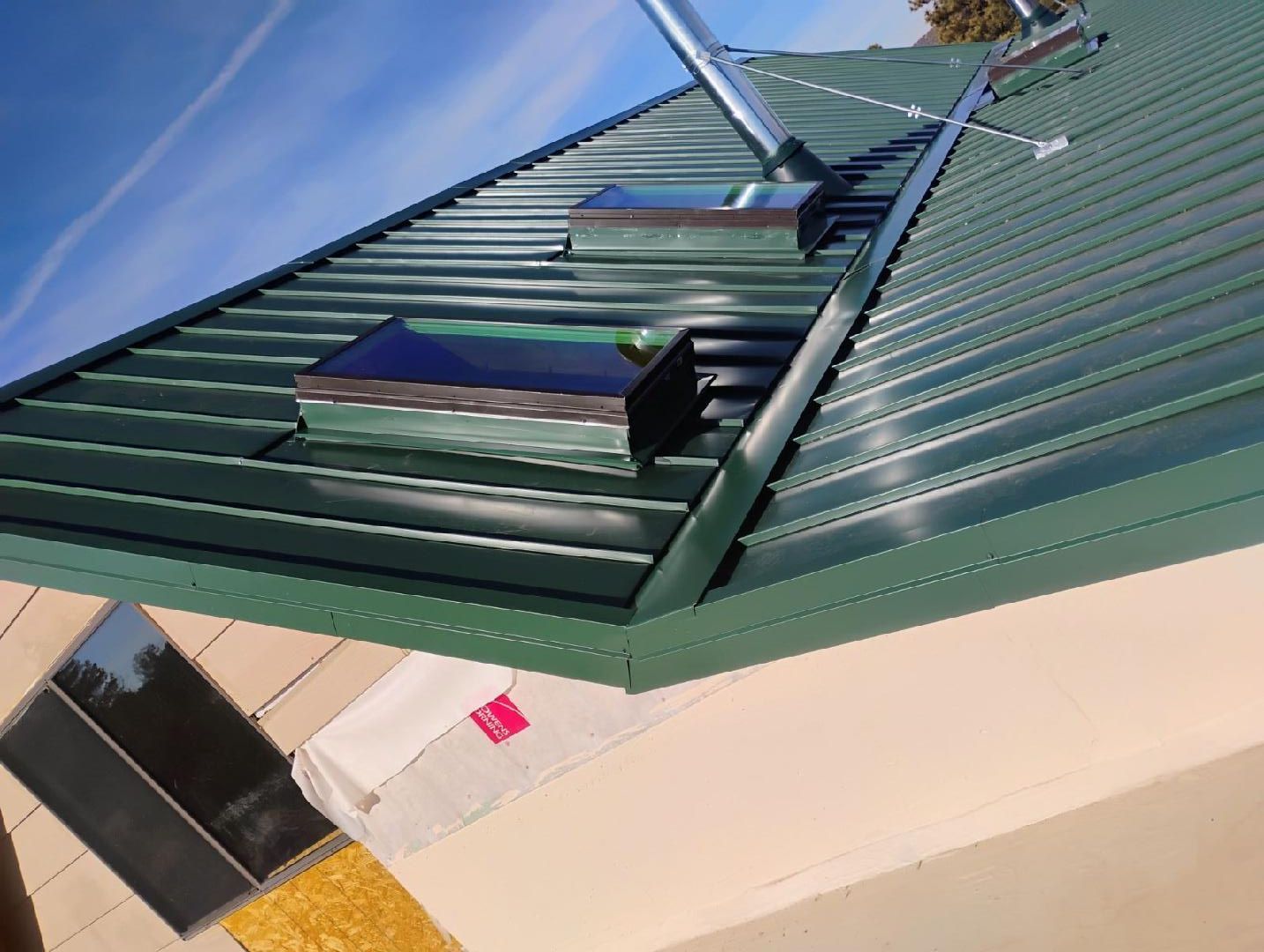
When it comes to roofing, homeowners and property managers are shifting away from traditional asphalt shingles and turning to something stronger, sleeker, and more sustainable — metal roofs. Once thought of as just a commercial solution or a rural barn essential, today’s metal roofing options are becoming a top choice for homes of all styles. But why the surge in popularity? Let’s take a closer look at what’s driving the metal roofing trend. 💪 Durability That Goes the Distance Metal roofs are built to withstand harsh weather , from monsoon downpours and heavy snow loads to high desert winds. Unlike shingles that may need replacing every 15-20 years, metal roofs can last 40-70 years with minimal maintenance. They're also fire-resistant, rot-proof, and insect-repellent , making them a smart choice in wildfire-prone areas like Arizona. 🌞 Energy Efficiency & Cost Savings Metal roofing reflects solar radiant heat, helping reduce cooling costs by up to 25% in hot climates . Many systems can be installed with added insulation or coated with reflective finishes, making them an eco-conscious and wallet-friendly option. 🎨 Aesthetic Appeal & Versatility Today’s metal roofs come in a variety of styles, colors, and textures — some mimic slate, wood shakes, or tile, while others offer a bold modern look. Whether your home is rustic, traditional, or contemporary, there's a metal roof to match. 🌎 Sustainable & Eco-Friendly Most metal roofing is made from recycled materials and is fully recyclable at the end of its life. It’s a great option for those looking to reduce their environmental footprint while investing in a long-lasting roof. 🛠️ Low Maintenance, High Reward Forget frequent repairs or missing shingles. With basic maintenance (like clearing debris and checking fasteners), a metal roof continues to perform year after year, even in extreme weather. Bottom Line: If you're looking for a roof that’s durable, energy-efficient, stylish, and built to last , metal might just be your perfect match. At Northern Arizona Roof Services , we’re proud to install high-quality metal roofs across Flagstaff, North Phoenix, and beyond. Want to explore your options? Let’s talk! 📞 Call us at 928-366-3504 or visit 🌐 northernarizonaroofservices.com
